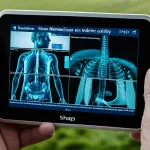Understanding Telemedicine and the Rural UK Healthcare Landscape
Telemedicine represents the use of digital technologies to deliver healthcare services remotely. It encompasses video consultations, remote monitoring, and electronic health records, allowing patients to connect with clinicians without physical visits. This core function addresses geographical barriers, especially crucial in rural healthcare settings.
Rural communities in the UK face distinct challenges within the UK healthcare system. Limited healthcare facilities, scarcity of specialists, and transportation hurdles contribute significantly to reduced access to quality care. These factors often result in longer travel times and waiting periods for patients needing medical attention.
Additional reading : How Can the UK Improve Public Well-being in the Health Sector?
Additionally, socioeconomic disparities and an aging population in rural areas exacerbate healthcare challenges. Traditional healthcare services struggle to meet these demands, intensifying the need for innovative approaches. Telemedicine offers a practical solution by bridging gaps, reducing the impact of distance, and enabling timely medical support. When effectively integrated into rural healthcare, telemedicine enhances accessibility and can improve patient outcomes by overcoming existing infrastructure and resource limitations.
Telemedicine Solutions for Rural Access Barriers
Telemedicine solutions have become pivotal in addressing rural healthcare access challenges across the UK. These digital healthcare platforms enable patients in remote locations to connect with medical professionals via virtual consultations. This approach significantly reduces the need for travel, which can be a major barrier for rural residents.
This might interest you : Unlock comfort and care with the best online pharmacy in uk
Virtual consultations allow healthcare providers to perform initial assessments, monitor chronic conditions, and offer timely advice without in-person visits. Additionally, remote diagnostics technologies, such as mobile health devices and home testing kits, support accurate data collection from patients’ homes. This data is then transmitted securely to clinicians, ensuring effective care delivery.
Integration with local healthcare providers is essential for successful telemedicine deployment. By collaborating with rural clinics and community health workers, digital healthcare solutions complement existing services, creating a seamless healthcare delivery method. This integrated model enhances continuity of care, allowing rural patients to access specialists who might otherwise be unavailable in their area.
Overall, telemedicine solutions represent a crucial advancement in overcoming rural access barriers, improving healthcare equity by leveraging technology and local resources.
Evidence of Telemedicine Impact in Rural UK Areas
The benefits of telemedicine have become increasingly clear through multiple case studies conducted in rural UK regions. For instance, pilot programs in Scotland and Wales reveal significant improvements in healthcare outcomes by reducing travel time for patients and enabling timely consultations with specialists. These studies show a marked increase in appointment attendance rates, reflecting better access to care.
Digital health statistics underline this trend, with one report showing a 30% rise in remote consultations across remote areas within one year. This growth corresponds directly to earlier diagnosis and management of chronic conditions, such as diabetes and heart disease, leading to reduced hospital admissions.
From the patient perspective, many express relief at avoiding long journeys, enabling them to maintain regular check-ups comfortably. Healthcare providers also note enhanced efficiency and the ability to monitor conditions more consistently.
Together, these empirical examples and quantitative data strongly support the positive impact of telemedicine. They demonstrate how embracing digital health can transform healthcare delivery, especially for those in hard-to-reach rural communities, ultimately improving health outcomes and patient satisfaction.
Key Advantages of Telemedicine for Rural Populations
Telemedicine benefits rural communities by significantly improving patient access to healthcare. Many rural patients face long travel distances to reach medical facilities, which delays care and increases costs. Telemedicine reduces travel by enabling consultations from home, saving time and money. This shift not only eases the burden on patients but also helps overcome transportation barriers that commonly prevent timely medical attention.
Improved healthcare efficiency is another critical advantage. Remote monitoring and virtual visits allow for more frequent follow-ups and quicker interventions, reducing hospital admissions and emergency visits. These timely actions enhance patient outcomes by catching health issues early.
Additionally, telemedicine supports better resource optimisation in rural healthcare. Providers can extend their reach without physically expanding facilities, allocating medical staff and equipment more effectively. This boosts service availability and quality without substantial infrastructure investment.
Together, these telemedicine benefits—reduced travel, improved access, and efficient use of healthcare resources—transform rural health systems. They make vital medical care more accessible, affordable, and responsive to the unique challenges rural populations face.
Challenges and Limitations in Implementing Telemedicine
Telemedicine faces significant telemedicine barriers that can impede its successful adoption across healthcare systems. A primary concern is the digital divide, where disparities in internet access and digital device availability limit participation, especially in rural or underserved communities. This gap exacerbates existing healthcare inequalities, leaving vulnerable populations with reduced access to remote consultations and follow-up care.
Another challenge is patient readiness and technology literacy. Many patients struggle with using telehealth platforms due to unfamiliarity with devices or software, which creates adoption hurdles. This is compounded by generational differences and socioeconomic factors influencing comfort with digital tools.
Furthermore, regulatory issues add complexity to telemedicine implementation. Privacy and data security considerations are paramount, as telemedicine must comply with strict health information protection regulations. Variability in legal frameworks across regions may cause uncertainty for providers and patients alike. Addressing these challenges requires robust digital infrastructure, user-friendly technology designs, and cohesive regulatory policies to minimize gaps and promote equitable telemedicine integration.
Future Implications and Recommendations for Rural UK Telemedicine
The future of telemedicine policy in rural UK hinges on targeted investments and supportive frameworks to ensure sustainable growth. Policymakers must prioritise funding for digital infrastructure, addressing connectivity gaps that inhibit rural healthcare access. Robust telemedicine policy should also include training programs for healthcare professionals to effectively use telehealth tools, enhancing patient outcomes.
Strengthening rural digital health ecosystems requires collaboration between government, private sector, and local communities. Building interoperable systems and promoting data sharing can streamline care coordination. Encouraging innovation through incentives, such as grants and pilot projects, will drive technological solutions suited to rural challenges.
Anticipated trends in rural healthcare reform focus on integrating wearable devices, AI diagnostics, and remote patient monitoring. These innovations promise more personalized and proactive care, reducing the burden on rural clinics. Embracing the digital health future means designing adaptable, user-friendly platforms to overcome barriers like digital literacy.
Overall, a strategic approach combining investment, policy, and innovation will accelerate healthcare innovation UK-wide, transforming rural telemedicine into a resilient and equitable model.




